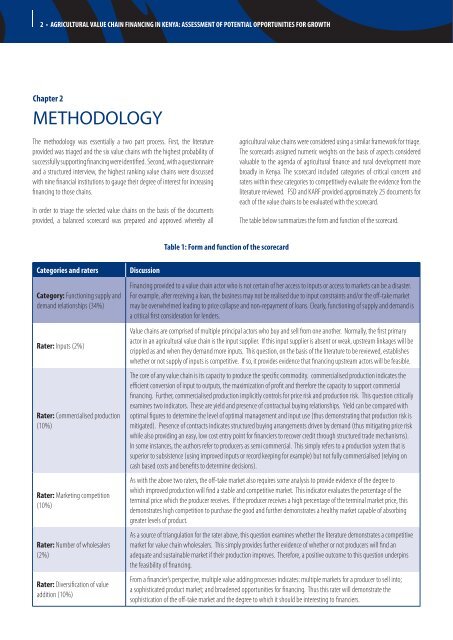AGRICULTURAL VALUe ChAIn FInAnCInG In KenYA
AGRICULTURAL VALUe ChAIn FInAnCInG In KenYA
AGRICULTURAL VALUe ChAIn FInAnCInG In KenYA
You also want an ePaper? Increase the reach of your titles
YUMPU automatically turns print PDFs into web optimized ePapers that Google loves.
2 • <strong>AGRICULTURAL</strong> VALUE CHAIN FINANCING IN KENYA: ASSESSMENT OF POTENTIAL OPPORTUNITIES FOR GROWTH<br />
Chapter 2<br />
METHODOLOGY<br />
The methodology was essentially a two part process. First, the literature<br />
provided was triaged and the six value chains with the highest probability of<br />
successfully supporting financing were identified. Second, with a questionnaire<br />
and a structured interview, the highest ranking value chains were discussed<br />
with nine financial institutions to gauge their degree of interest for increasing<br />
financing to those chains.<br />
<strong>In</strong> order to triage the selected value chains on the basis of the documents<br />
provided, a balanced scorecard was prepared and approved whereby all<br />
Categories and raters Discussion<br />
Category: Functioning supply and<br />
demand relationships (34%)<br />
Rater: <strong>In</strong>puts (2%)<br />
Rater: Commercialised production<br />
(10%)<br />
Rater: Marketing competition<br />
(10%)<br />
Rater: Number of wholesalers<br />
(2%)<br />
Rater: Diversification of value<br />
addition (10%)<br />
Table 1: Form and function of the scorecard<br />
agricultural value chains were considered using a similar framework for triage.<br />
The scorecards assigned numeric weights on the basis of aspects considered<br />
valuable to the agenda of agricultural finance and rural development more<br />
broadly in Kenya. The scorecard included categories of critical concern and<br />
raters within these categories to competitively evaluate the evidence from the<br />
literature reviewed. FSD and KARF provided approximately 25 documents for<br />
each of the value chains to be evaluated with the scorecard.<br />
The table below summarizes the form and function of the scorecard.<br />
Financing provided to a value chain actor who is not certain of her access to inputs or access to markets can be a disaster.<br />
For example, after receiving a loan, the business may not be realised due to input constraints and/or the off-take market<br />
may be overwhelmed leading to price collapse and non-repayment of loans. Clearly, functioning of supply and demand is<br />
a critical first consideration for lenders.<br />
Value chains are comprised of multiple principal actors who buy and sell from one another. Normally, the first primary<br />
actor in an agricultural value chain is the input supplier. If this input supplier is absent or weak, upstream linkages will be<br />
crippled as and when they demand more inputs. This question, on the basis of the literature to be reviewed, establishes<br />
whether or not supply of inputs is competitive. If so, it provides evidence that financing upstream actors will be feasible.<br />
The core of any value chain is its capacity to produce the specific commodity. commercialised production indicates the<br />
efficient conversion of input to outputs, the maximization of profit and therefore the capacity to support commercial<br />
financing. Further, commercialised production implicitly controls for price risk and production risk. This question critically<br />
examines two indicators. These are yield and presence of contractual buying relationships. Yield can be compared with<br />
optimal figures to determine the level of optimal management and input use (thus demonstrating that production risk is<br />
mitigated). Presence of contracts indicates structured buying arrangements driven by demand (thus mitigating price risk<br />
while also providing an easy, low cost entry point for financiers to recover credit through structured trade mechanisms).<br />
<strong>In</strong> some instances, the authors refer to producers as semi commercial. This simply refers to a production system that is<br />
superior to subsistence (using improved inputs or record keeping for example) but not fully commercialised (relying on<br />
cash based costs and benefits to determine decisions).<br />
As with the above two raters, the off-take market also requires some analysis to provide evidence of the degree to<br />
which improved production will find a stable and competitive market. This indicator evaluates the percentage of the<br />
terminal price which the producer receives. If the producer receives a high percentage of the terminal market price, this<br />
demonstrates high competition to purchase the good and further demonstrates a healthy market capable of absorbing<br />
greater levels of product.<br />
As a source of triangulation for the rater above, this question examines whether the literature demonstrates a competitive<br />
market for value chain wholesalers. This simply provides further evidence of whether or not producers will find an<br />
adequate and sustainable market if their production improves. Therefore, a positive outcome to this question underpins<br />
the feasibility of financing.<br />
From a financier’s perspective, multiple value adding processes indicates: multiple markets for a producer to sell into;<br />
a sophisticated product market; and broadened opportunities for financing. Thus this rater will demonstrate the<br />
sophistication of the off-take market and the degree to which it should be interesting to financiers.
















